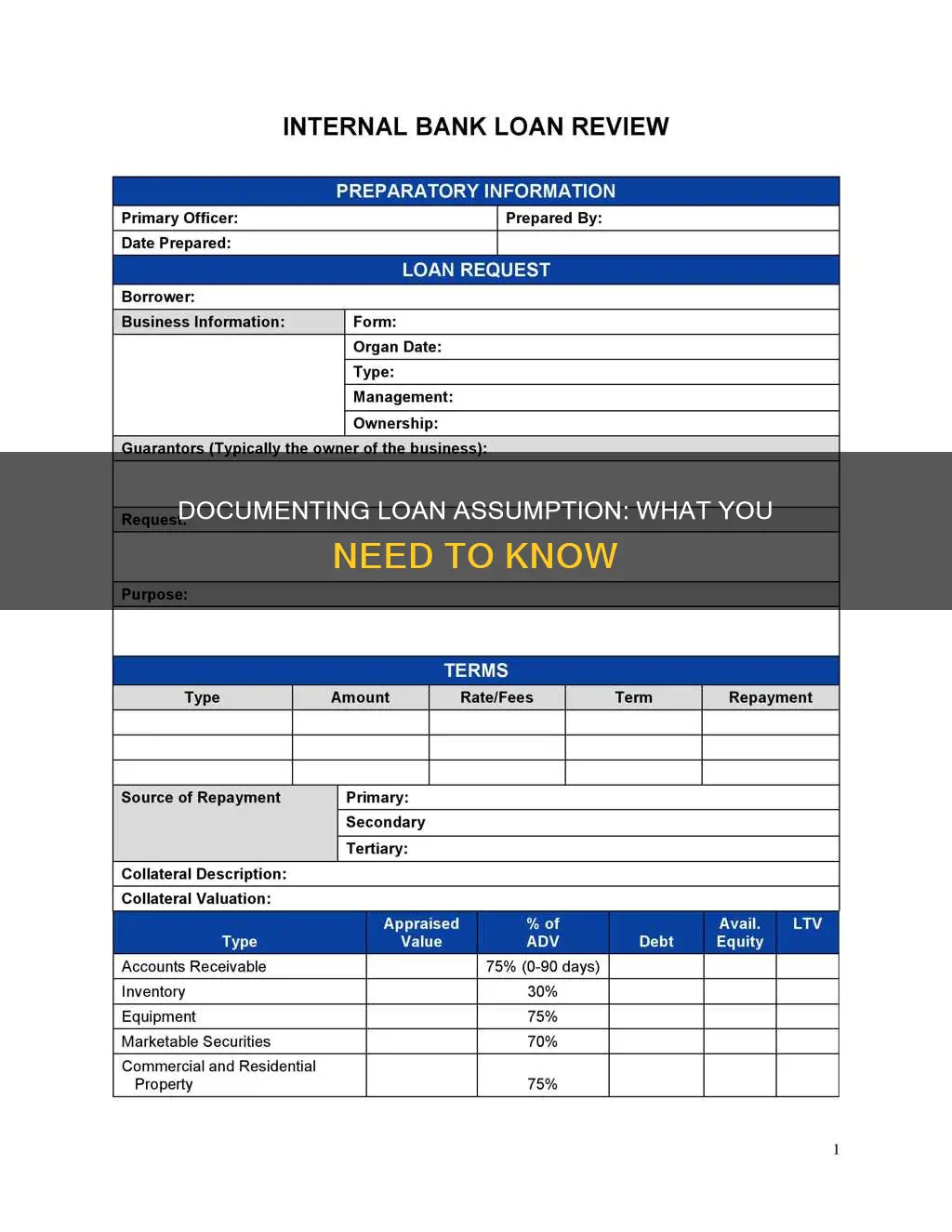
A loan assumption, also known as an assumable mortgage, is when a borrower takes over another borrower's existing home loan. This is documented through a mortgage assumption agreement, which shifts the financial responsibility of the loan to a new borrower. The original mortgage agreement is the first document needed in the mortgage assumption process, which includes the original terms of the mortgage, loan amount, interest rate, monthly payments, and maturity date. The buyer must then be approved by the lender, who will assess their financial means and ensure they are not a financial risk. The seller must also provide written authorisation to the lender to transfer the loan.
| Characteristics | Values |
|---|---|
| Type of loan assumption | Novation (safest type) or simple assumption |
| Requirements | Original loan documentation must include an assumption clause |
| New borrower must be approved by the lender | |
| Lender must ensure the borrower has the financial means to repay the loan | |
| Lender must ensure the borrower isn't a serious financial risk | |
| Fees | Typically between 0.05% and 1% of the original loan amount |
| For FHA loans being transferred by assumption, fees are capped at $500 | |
| For FHA loans transferred via simple assumption, the maximum fee is $125 | |
| Borrowers who assume an FHA loan will be responsible for FHA mortgage insurance premiums | |
| CMBS loans are assumable for a small fee (typically 1%) | |
| No fees for VA loans | |
| Documentation | Original mortgage agreement |
| Mortgage assumption application | |
| Seller must provide written authorization to allow the lender to transfer the loan | |
| Property appraisal | |
| Title report or title search |
What You'll Learn

The original mortgage agreement
If the original mortgage agreement is not available, it can be requested from the lender or the title company handling the transaction. This document is crucial, as it forms the basis for assessing whether the buyer is financially qualified to assume the mortgage. The buyer's mortgage assumption application will include personal details, financial information, and employment history, which will be evaluated against the original mortgage agreement.
Overall, the original mortgage agreement is a critical component of the loan assumption process, as it provides the necessary information for the lender, seller, and buyer to understand the financial commitments, assess the buyer's qualifications, and ensure a smooth and efficient transfer of the loan responsibilities.
Grace Loan Advance: Understanding This Unique Financial Offering
You may want to see also

Lender approval
In the context of mortgage assumption, lenders typically require an appraisal to ensure that there is sufficient equity in the property. This protects the lender by confirming that the loan is adequately secured by the value of the property. Lenders may also charge their own separate fee for the loan assumption, which can range from $800 to $1,000 or even up to 1% of the loan amount.
The type of loan assumption can impact the level of lender involvement and approval. Novation, considered the safest type of loan assumption, requires the lender's approval and includes the buyer undergoing the underwriting process. In this case, the lender releases the seller from all future liability for the mortgage payments. On the other hand, simple assumption is a private transfer of responsibility without the lender's approval, which is a much riskier transaction.
It is important to note that not all loans are assumable, and there may be restrictions on loan assumptions. The loan documents will typically include an "assumption clause" or "due-on-sale clause" that indicates whether loan assumption is permitted. If the loan was made after the Dodd-Frank Act regulatory changes, this information can also be found in the Closing Disclosure. In some cases, special circumstances, such as death or inheritance, may exempt the lender from checking the buyer's creditworthiness and approving the sale.
Overall, lender approval for loan assumption involves a comprehensive assessment of the new borrower's financial situation, the property's equity, and adherence to the specific requirements and restrictions outlined in the loan documents.
Steps to Become a Loan Signing Agent in Georgia
You may want to see also

Buyer's financial capacity
The financial capacity of the buyer is a critical aspect of loan assumption. Buyers must meet specific requirements and receive approval from the agency sponsoring the mortgage. This includes demonstrating creditworthiness and meeting income criteria. For example, FHA loans require a minimum credit score of 620, while VA loans have their own standards for creditworthiness and income. Buyers must also be able to cover the seller's equity, which is the difference between the home's purchase price and the remaining loan balance. This can be done in cash or through additional financing.
Additionally, buyers should be aware of the potential for higher down payment requirements and ensure they can afford the mortgage payments. In some cases, buyers may need to take out a second loan to cover the seller's equity, which increases the risk of default if the second loan has a higher interest rate. It is important for buyers to carefully evaluate their financial capacity before entering into a loan assumption agreement.
To assess their financial capacity, buyers should consider their income, savings, and other assets. They should also be aware of their credit score and debt-to-income ratio, as these factors will be evaluated by the lender during the approval process. Buyers may also want to have an appraisal done to ensure they are not overpaying for the property and to accurately value the property before assuming the loan.
Furthermore, buyers should be aware of any liens or other encumbrances on the property that may need to be addressed before assuming the loan. In some cases, a title search may be necessary to identify any outstanding issues. By carefully evaluating their financial capacity and considering all relevant factors, buyers can make informed decisions about their ability to take on the existing loan and ensure a smooth loan assumption process.
Understanding Loan Policies: What Borrowers Should Know
You may want to see also

Property appraisal
In addition to the appraisal, a title search should be performed to identify any liens or other encumbrances on the property that fall outside the scope of the mortgage. These would need to be addressed before assuming the loan. It is also crucial to determine whether the mortgage is eligible for assumption, as not all mortgages are assumable. Conventional loans, for example, typically contain a "due-on-sale" clause, requiring the mortgage to be paid off if the property is transferred.
If the property appraisal reveals that the current value of the home is higher than the remaining principal balance (home equity), the buyer will need to cover the difference at closing. This can be done through cash or a second mortgage loan, depending on the maximum CLTV determined by the lender. It is worth noting that the buyer assuming the loan may need to bring additional funds to the table to compensate the seller for any home equity they have built.
The buyer will need to go through the application and underwriting process to qualify with the mortgage lender. This includes providing financial information, such as income and asset documentation, and meeting credit and income requirements. The lender will assess the buyer's financial qualifications to ensure they can take on the existing loan payments.
Overall, a thorough property appraisal and due diligence process are crucial steps in the loan assumption process to protect the buyer's interests and ensure a smooth transfer of the loan.
Steps to Become a Loan Signing Agent
You may want to see also

Assumption fees
FHA loans being transferred by assumption have fees capped at $500, unless the transfer is via simple assumption, in which case the maximum fee is $125. All VA loans are assumable, but anyone assuming a VA loan will have to pay the VA funding fee, unless they qualify for an exemption. Most USDA loans are assumable, which transfers responsibility for the mortgage debt to the buyer while adjusting the loan terms.
In many cases, a buyer must pay a fee to assume a loan, typically between 0.05% and 1% of the original loan amount. This fee is meant to cover the costs of processing and transferring the loan to the new borrower. The buyer may also be required to provide financial information, such as tax returns and a personal financial statement, to qualify for the loan assumption.
While assumption fees can save the buyer money on closing costs and lower interest rates, it is important to note that the buyer may still need to put down a higher down payment to cover the original borrower's equity. Additionally, the buyer becomes liable for any missed loan payments by the seller.
Mr. Cooper's HELOC Loan Options: What You Need to Know
You may want to see also
Frequently asked questions
A loan assumption is when a borrower takes over another borrower's existing home loan.
A loan assumption offers the buyer the potential for lower interest rates or more favourable loan terms. It also allows the seller to transfer the property without needing to pay off the mortgage in full.
The biggest drawback of a loan assumption is the higher down payment.
The original mortgage agreement is the first document needed in the loan assumption process. This document contains the original terms of the mortgage, including the loan amount, interest rate, monthly payments, and maturity date. The lender will use this document to assess whether the mortgage can be transferred. The buyer will also need to fill out a mortgage assumption application, which will include personal details, financial information, and employment history.







